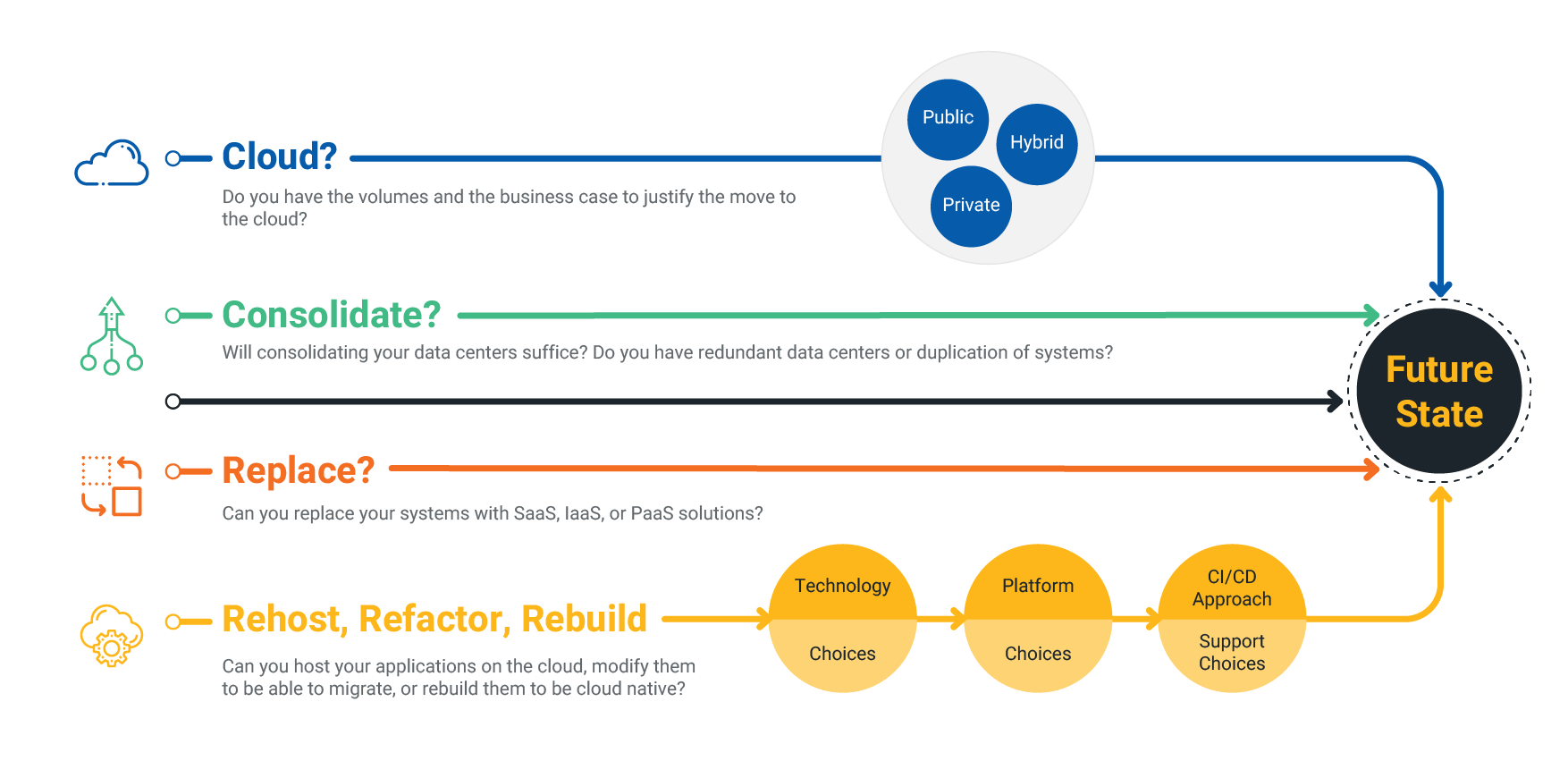Digital Transformation and traditional Data Center Exit
Data centers have been a core and integral part of the IT ecosystems for companies for decades. For some companies, data centers are the nerve centers of the organization. However, digital transformation is adding stress to many data centers and requiring them to have a faster response for time to market and be more accessible to deploy innovative technologies that make their business more agile and more globally competitive. Today’s data centers are not always fit for this purpose when supporting the new pace of business and providing the required technology flexibility, agility, and security. Moreover, the data center is increasingly seen as a costly, restrictive, and distracting burden, often consuming resources that could add more direct value to the enterprise.
Gartner predicts that by 2025, 80% of enterprises will shut down their traditional data centers in favor of 100% cloud operations. Ten percent of organizations already have.

The data center on-premises can have a limited age range from 10 to 15 years. But being locked up in a long-term engagement with the data center can impede your business growth potential. There is a confluence of multiple triggers like the urgent business need for capacity and storage to support expansion plans, software and hardware refresh cycles, growing security threats, compliance commitments, or the need to deliver applications faster and more geographically distributed based on business demand. This causes corporate data centers to exit and see more benefits in migrating to the cloud, especially with the CAPEX benefits and cloud-based subscription model. It puts more pressure on CIOs to improve IT efficiency, reduce cost, or even eliminate on-premises data centers by moving existing applications and services to the cloud. Here are significant reasons why companies have decided on data center exit.
High Total Cost of Ownership (TCO)
TCO includes the overall cost of the entire data center, including infrastructure investment, operation, maintenance upgrades, and related expenses of managing an entire data center landscape. Building and maintaining a company’s own data center requires a tenanted facility, paying the utility, energy, lease line, and other bills while maintaining your hardware, IT infrastructure, and software. Other than that, you have hardware and software license costs, maintenance, upgrades, support, security, and training costs, increasing with time. You also need significant investment to keep your systems, app, and infrastructure operational and provide enough capacity to meet growing business demands. One of the more significant costs of data centers today is personnel. As data centers become more complex and the skills to run them become more scarce, the costs increase along with the risks.
Evolving and changing business needs
Data sovereignty, regulatory requirements (such as GDPR), and business requirements of low latency, factors like these drive the need for workloads to be accessible from multiple locations. Primarily datacenters are meant for a particular purpose only and do not effectively and timely support resources scaling and challenges in application resiliency and low latency. Traditional data centers have limited capacity to meet these business needs. At the very least, the majority of companies have addressed this challenge by adding cloud services in concert with data center operations.
Security concerns
One constant challenge in the data center is security, and security breaches are on the rise. Companies find that they need to spend more resources just to keep up with current threats. Security software and frameworks implemented in the on-premises data center are often not enough to guarantee the safety of the data housed in a facility. Any data breach in a data center could cost millions of dollars in lost intellectual property, confidential data leakage, and stolen personal information. Risk management and data security are the main concerns of every data center administrator. Furthermore, data centers require significant improvements and investment to align with new security threats.
Motivation for cloud migration
Cloud is at the epicenter of the digital transformation revolution. The cloud has changed everything in how we implement and manage IT in our data center. It is reasonable to say that all modern applications are developed with a “cloud-first” approach. For existing workloads, migrating to the cloud can help transform your business by leveraging technology that allows you to provision and consume computing resources as needed instead of making expensive upfront investments in the data center to manage ad-hoc workloads. It is a shift in the way you invest in your technology infrastructure, and it offers unlimited flexibility in design, implementation, and cost. Other tempting cloud capabilities include a pay-as-you-go model, service level agreements, high data and application availability, automation for performance assurance, transparent refresh management, and robust security and compliance management. Businesses move to the cloud seeking a variety of benefits in the new business scenario:
Cost: Organizations can move IT spending from capital expenditure (Capex) to operational expenditure (OpEx) using a cloud platform. The fixed costs investment associated with shared infrastructure are avoided, and the cloud also provides greater visibility into the actual price of individual applications. Thus, it dramatically lowers the cost of innovation, enabling faster time to market. It also results in an increase in agility that reduces innovation costs and enables a quicker time-to-market. The cloud’s scale, performance, reliability, and global reach allow small development teams to develop global services for global audiences.
Agility: Traditional on-premises infrastructure usually takes weeks or even months to deploy, whereas the cloud provides instant provisioning of IT resources with few clicks. It enables IT to move much more quickly without over-provisioned resources in advance or spending too much time on infrastructure planning and deployment. Leveraging modern DevOps, companies are building infrastructure as code within applications, using containers to quickly deploy code in a virtual environment with minimum risk.
Service quality: Cloud infrastructure is designed to meet today’s demanding workloads. It offers significant performance, reliability, and security improvements over an on-premises data center.
New scenarios: Apart from existing services migrating to the cloud, it enables new cloud-native apps and scenarios such as big data storage and analytics, machine learning, and IoT, which are not possible, or would be expensive to deliver using the on-premises infrastructure. These technologies enable new application scenarios, innovation, and competitive advantages only available with the cloud.
Greater ability to focus on innovation: You can free your IT resources on your core business by offloading their main admin’s tasks to the cloud providers. Your IT teams can stop worrying about keeping our infrastructure up and running and focus on innovating without heartburn.
Security and Compliance: Cloud service providers provide comprehensive security at every touchpoint compared to traditional data centers. Most cloud providers have built-in security features for threat intelligence, automatic security updates, analytics, enterprise-wide security dashboards, etc. They address security issues like firewall, load balancing, and automated security to secure your system and infrastructure from being vulnerable to the latest security threats. Most of the cloud has compliance certifications coverage, including ISO27001, PCI-DSS, AICPA/SOC, and HIPAA.
Data center exit strategy and moving from an on-premises data center to cloud
We understand that data center exit can be a frightening and complex process for organizations. You need a well-structured and planned data center exit strategy to move from your on-premises data center to cloud. Whether your current data center is complex or simple, migrating to the cloud is always complicated with organization-specific challenges and consequences—some familiar challenges and obstacles in migrating applications, data, and infrastructure from datacenters to the cloud.
Here are some critical data center exit strategies and steps for moving to cloud.
Creating the business value case is crucial to making a solid starting point with a complete and justified business case. You need to understand your current business requirement and visualize the future roadmap. Assess and evaluate your current estate and articulate how the migration to a cloud environment will work in the cloud and what benefits the organization would get from migration. Draft and place a Return of Investment (ROI) report to articulate the business value, propose the budget, and resource request with detailed timelines and milestones.
Data and business downtime – Planning mistakes made in data center migrations can lead to costly business downtime, reduced end-user productivity, and the loss of important data. Before migrating to the cloud, you need to back up all your data and app with restoration and failover options. If anything does not go according to the migration planning, you always have a copy of the backup; you can rectify the errors and restore the data to its previous condition.
Proper planning- Full readiness, comprehensive assessment, and preparation for migration can drive success and reduce the complexity and risks. You need to ensure you pull the well-suited architecture and security best practices when migrating. It would help if you had a full assessment of your existing data center portfolio and made an ideal cloud strategy (lift and shift, refactoring, re-platforming, etc.) and proper cloud platform selection. Migrating your data center to the cloud also involves security risks, compliance violations, external attacks, etc. You should be able to oversee these risks and make your team aware of them.
Recommendations
The mission-critical legacy applications that run on the data center need to be evaluated very carefully; any change or alteration represents a business risk. Your data center exit should be seamless and safe; it is a highly technical endeavor and requires skills and experience. When you partner with migration experts like Hexaware, you can successfully overcome both expected and unexpected challenges to exiting the data center. Hexaware helps enterprises realize and adapt digital future while optimizing IT operational efficiency, increasing agility, and reducing cost. Hexaware can help you reduce complexity and leverage the cloud better, irrespective of the corporate landscape of your data center.
Hexaware Amaze® Migration Platform
Hexaware’s Amaze® migration platform provides an automated methodology for your data center migration and offers a well-structured data center exit strategy and approach. It helps you discover, assess, migrate, and optimize your cloud migration journey. We offer a free assessment of your data center, including physical and virtual servers’ assessment, and provide recommendations on the optimized cloud design. We also provide the estimated cloud cost and approaches to the migration.



















